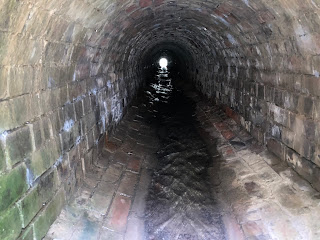Not that we wish to sound like some farmers for whom the weather is never perfect, we certainly noticed the change to wet conditions at the end of Winter. After writing in many culvert inspection reports that the flow was minimal and the cess drains were just damp we had the opposite for the final few. After a few wet days, a lot of our culverts were flowing well. Whilst checking in wet conditions is a benefit, it does preclude taking photographs looking into the culvert bore. The water is just too deep to stand in and the banks too slippery as well. However, we now have finally caught up with the COVID-19 induced backlog of internal visual inspections of culverts and cross drains. This season’s round will commence towards the end of summer.
Thursday 3rd March
First job for whole team of five today was replacing two damaged manhole lids near Southam Lane bridge, including that shown in the previous blog post. This required all five as we had to use barrows to transport the lids from the nearest level road access point, the RDA crossing at Cheltenham. Whilst there we also inspected the metal covers on the driveway which runs between the RDA crossing and Cheltenham signal box - this drive is used for race vehicle traffic during race week. Glad to say we found no issues.
Following the lid replacement, we split into two teams. First sub-team one then proceeded to south of Hunting Butts tunnel to undertake visual examination of culverts 44A and 45A; the last two of the 2021 inspection programme. 44A carries a small stream between Hunting Butts tunnel and Swindon Lane; however it is of great importance as all the drainage from Cheltenham Racecourse station flows to it through Hunting Butts tunnel and the down side cess.
 |
| Looking down the bore of culvert 44A, water not too deep but flowing fast. |
45A is a much larger structure; it is right on the boundary of our land by the Prince of Wales Stadium. It carries the Wymans Brook, which is piped from the lakes in Pitville Park. Hence on the down side there is just a very deep manhole; whilst on the upside there is a large headwall and the stream flows by the side of a public footpath. Being near to the Midland Mainline we could here lots of trains whilst we were working – of course not on the GWSR as there is no track south of Hunting Butts.
 |
| Up side outlet headwall of culvert 45A, Wymans Brook. Not taken by standing in the water! |
The second sub-team headed to Working Lane where they completed the backfill of the new haul road exit headwall on culvert 24B. This almost completed the work on 24B, one of the components of the Royal Oak/Working Lane improvement programme. The wet and muddy conditions meant no progress on the excavations for the concrete apron on culvert 24C.
The whole team met for lunch, in the luxurious (for us) C&W mess at Winchcombe (thanks guys and girls). After lunch with rain threatening, we continued with milepost construction in the workshop. This included priming two lengths of bridge rail; preparing steel bar for dividers and quarter marks; painting numbers and making galvanised caps. We now have three new heads complete and ready for installation.
 |
| The milepost production bench in the workshop. No we don't have a mile 91; it is 16¼ up side down. Its location is between Gotherington and Bishops Cleeve. |
Thursday 10th March
An even smaller team of four today, the others had a variety of excuses (funeral, work, partners illness). However, they managed to complete several diverse tasks.
First was a request from the Bridge Engineer to recover some surplus sheets of galvanised mesh from Stanton Yard. This is the bird nesting prevention material, it was the surplus from the contract job for the B4632 Bridge (8) and Stanton Road Bridge (10). Whilst at Stanton, the team took a note of the amount of building stone available. This should be enough for the work on culvert 24C at Working Lane, thus avoid purchasing a new load.
Next job was to move a pallet of solid concrete blocks from Winchcombe to Working Lane. These will be used in the construction of the exit headwall on culvert 24C. They are a lot lighter and thus easier to handle than the large hollow blocks of 1950s vintage we used on 24B and 24A.
The weather and ground conditions were dry enough for the completion of the excavation at 24C for the concrete apron for the new headwall. The shuttering was installed as well; so next week concreting should commence.
 |
| Culvert 24C exit by the haul road at Working Lane. Excavation complete and shuttering in place ready for pouring the concrete apron. (Photo by Martin) |
 |
| The final touch to the up side of 24B, safety rails by the haul road. (Photo by Martin) |
The final job of the day was to produce four new milepost head caps. This used some pieces of lead flashing left over from the Broadway station canopy extension project. Thanks to the C&M team for putting it by. Also thanks to a Trust member (Keith in Gloucester) for donating a roll of lead flashing he had surplus. That too will be made into milepost head caps, there are many between Winchcombe and Toddington that need a cap added. We plan to accomplish that in situ, as bending lead to fit does not require workshop facilities.
Very interesting blog thank you
ReplyDelete